Imaging the Corrosion in Grounding Grid Branch with Inner-Source Electrical Impedance Tomography
Abstract
:1. Introduction
2. Model and Algorithm
2.1. The Physical Model
2.2. The Forward Problem
2.3. The Inverse Problem
3. Corrosion Diagnosis Method
3.1. Potential Measurement
3.2. The Soil-Separation Method
3.3. The Block-Diagnosis Method
4. Simulation Discussion
4.1. Different Shape of the Grounding Grid Block
4.2. The Amount of the Measurements
4.3. Different Corrosion Degrees
5. Experimental Analysis
5.1. Laboratory Experiment
5.2. Field Experiment
6. Conclusions
Author Contributions
Funding
Acknowledgments
Conflicts of Interest
References
- Yu, C.G.; Fu, Z.H.; Wu, G.L.; Zhou, L.Y.; Zhu, X.G.; Bao, M.H. Configuration detection of substation grounding grid using transient electromagnetic method. IEEE Trans. Ind. Electron. 2017, 64, 6745–6783. [Google Scholar] [CrossRef]
- Ackerman, A.; Sen, P.K.; Oertli, C. Designing safe and reliable grounding in AC substations with poor soil resistivity: An interpretation of IEEE Std. 80. IEEE Trans. Ind. Appl. 2013, 49, 1883–1889. [Google Scholar] [CrossRef]
- Ko, J.W.; Cha, H.L.; Kim, D.K.-S.; Lim, J.R.; Kim, G.G.; Bhang, B.G.; Won, C.S.; Jung, H.S.; Kang, D.H.; Ahn, H.K. Safety analysis of grounding resistance with depth of water for floating PVs. Energies 2017, 10, 1304. [Google Scholar] [CrossRef]
- Zhang, B.; Jiang, Y.K.; Wu, J.P.; He, J.L. Influence of potential difference within large grounding grid on fault current division factor. IEEE Trans. Power Deliv. 2014, 29, 1752–1759. [Google Scholar] [CrossRef]
- Harid, N.; Griffiths, H.; Mousa, S.; Clark, D.; Robson, S.; Haddad, A. On the analysis of impulse test results on grounding systems. IEEE Trans. Ind. Appl. 2015, 51, 5324–5334. [Google Scholar] [CrossRef]
- Zhu, Y.; Li, Y.P.; Sang, J.B.; Bao, M.L.; Zang, H.X. Analysis and improvement of adaptive coefficient third harmonic voltage differential stator grounding protection. Energies 2018, 11, 1430. [Google Scholar] [CrossRef]
- Zhu, X.S.; Cao, L.L.; Yao, J.F.; Yang, L.; Zhao, D. Research on ground grid diagnosis with topological decomposition and node voltage method. In Proceedings of the 2012 Spring Congress on Engineering and Technology, Xian, China, 27–30 May 2012; pp. 1–4. [Google Scholar]
- Xu, L.; Li, L. Fault diagnosis for grounding grids based on electric network theory. Trans. China Electrotech. Soc. 2012, 27, 270–276. [Google Scholar]
- Hu, J.Y.; Hu, J.G.; Lan, D.L.; Ming, J.L.; Zhou, Y.T.; Li, Y.W. Corrosion evaluation of the grounding grid in transformer substation using electrical impedance tomography technology. In Proceedings of the IEEE Industrial Electronics Society, Beijing, China, 18 November 2017; pp. 5033–5038. [Google Scholar]
- Zhang, B.; Zhao, Z.B.; Cui, X.; Li, L. Diagnosis of breaks in substation's grounding grid by using the electromagnetic method. IEEE Trans. Magn. 2002, 38, 473–476. [Google Scholar] [CrossRef]
- Yu, C.G.; Fu, Z.H.; Wang, Q.; Tai, H.M.; Qin, S.Q. A novel method for fault diagnosis of grounding grids. IEEE Trans. Ind. Appl. 2015, 51, 5182–5188. [Google Scholar] [CrossRef]
- Yu, C.G.; Fu, Z.H.; Hou, X.Z.; Tai, H.M.; Su, X.F. Break-point diagnosis of grounding grids using transient electromagnetic apparent resistivity imaging. IEEE Trans. Power Deliv. 2015, 30, 2485–2491. [Google Scholar] [CrossRef]
- Liu, K.; Yang, F.; Zhang, S.Y.; Zhu, L.W.; Hu, J.Y.; Wang, X.Y.; Irfan, U. Research on grounding grids imaging reconstruction based on magnetic detection electrical impedance tomography. IEEE Trans. Magn. 2018, 54, 1–4. [Google Scholar] [CrossRef]
- Braun, F.; Proenca, M.; Sola, J.; Thiran, J.; Adler, A.A. Versatile noise performance metric for electrical impedance tomography algorithms. IEEE Trans. Biomed. Eng. 2017, 64, 2321–2330. [Google Scholar] [CrossRef] [PubMed]
- Murphy, E.; Mahara, A.; Halter, R. Absolute reconstructions using rotational electrical impedance tomography for breast cancer imaging. IEEE Trans. Med. Imag. 2016. 36, 892–903. [CrossRef]
- Yang, Y.J.; Jia, J.B.; Smith, S.; Jamil, N.; Gamal, W.; Bagnaninchi, P. A miniature electrical impedance tomography sensor and 3D image reconstruction for cell imaging. IEEE Sens. J. 2017, 17, 514–523. [Google Scholar] [CrossRef]
- Li, C.L.; He, W.; Yao, D.G.; Yang, F.; Kou, X.K.; Wang, X.Y. Topological measurement and characterization of substation grounding grids based on derivative method. Int. J. Eelectron. Power 2014, 63, 158–164. [Google Scholar]
- Fu, Z.H.; Song, S.Y.; Wang, X.J.; Li, J.Q.; Tai, H.M. Imaging the topology of grounding grids based on wavelet edge detection. IEEE Trans. Magn. 2018, 54, 1–8. [Google Scholar] [CrossRef]
- Susanne, B.; Ridgway, S. The Mathematical Theory of Finite Element Method, 3rd ed.; Texts in Applied Mathematics: California, CA, USA, 2008; pp. 155–172. [Google Scholar]
- Hofmann, B. Penalty methods for the inverse problem in EIT. Physiol. Meas. 1996, 17, A73. [Google Scholar] [CrossRef] [PubMed]
- Johnston, R.; Gulrajani, M. Selecting the corner in the L-curve approach to Tikhonov regularization. IEEE Trans. Biomed. Eng. 2000, 47, 1293–1396. [Google Scholar] [CrossRef] [PubMed]
- Yang, F.; Wang, Y.A.; Dong, M.L.; Kou, X.K.; Yao, D.G.; Li, X.; Gao, B.; Irfan, U. A cycle voltage measurement method and application in grounding grids fault location. Energies 2017, 10, 1929. [Google Scholar] [CrossRef]
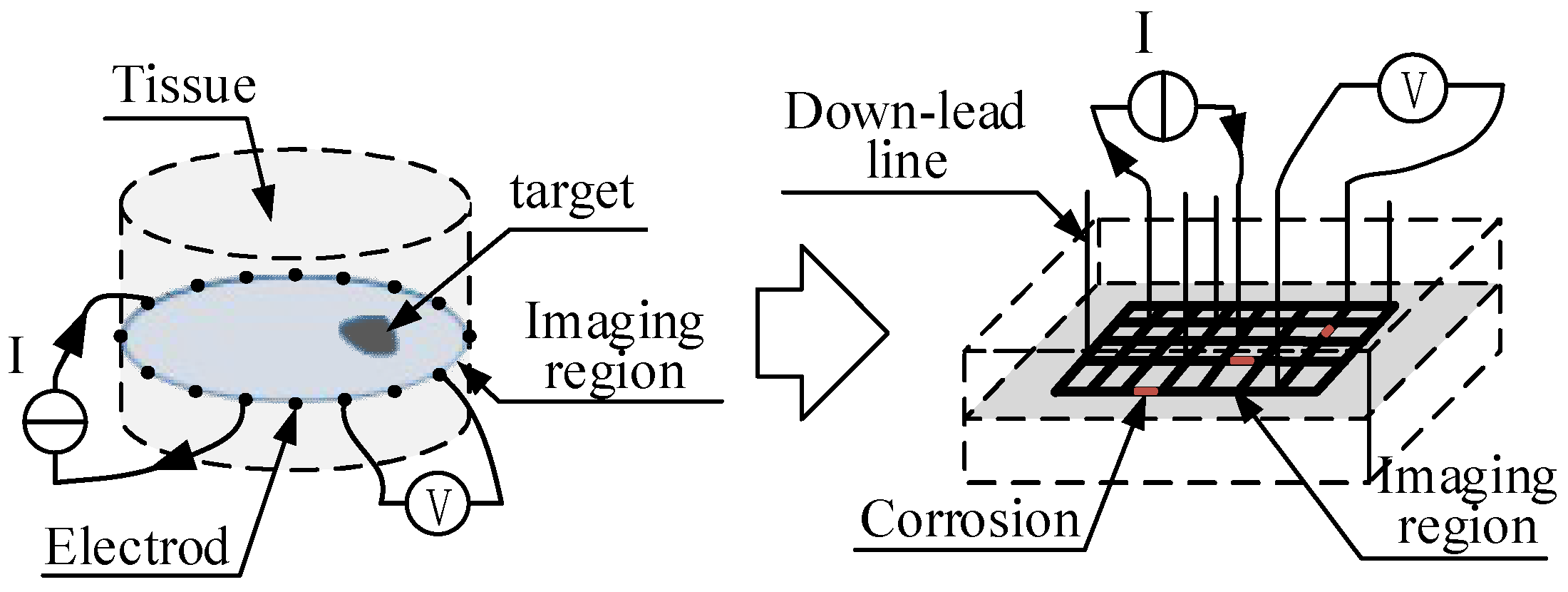

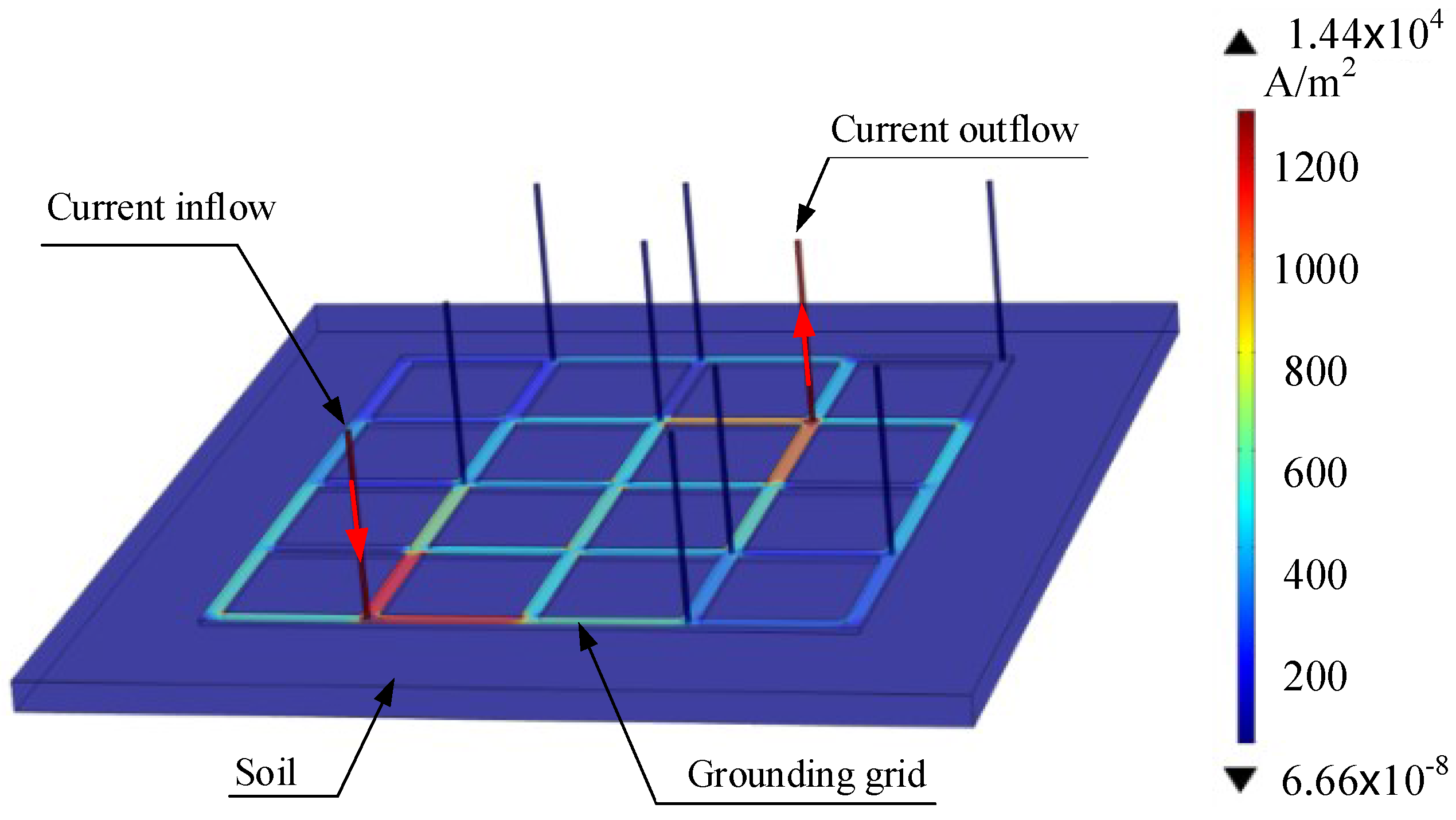
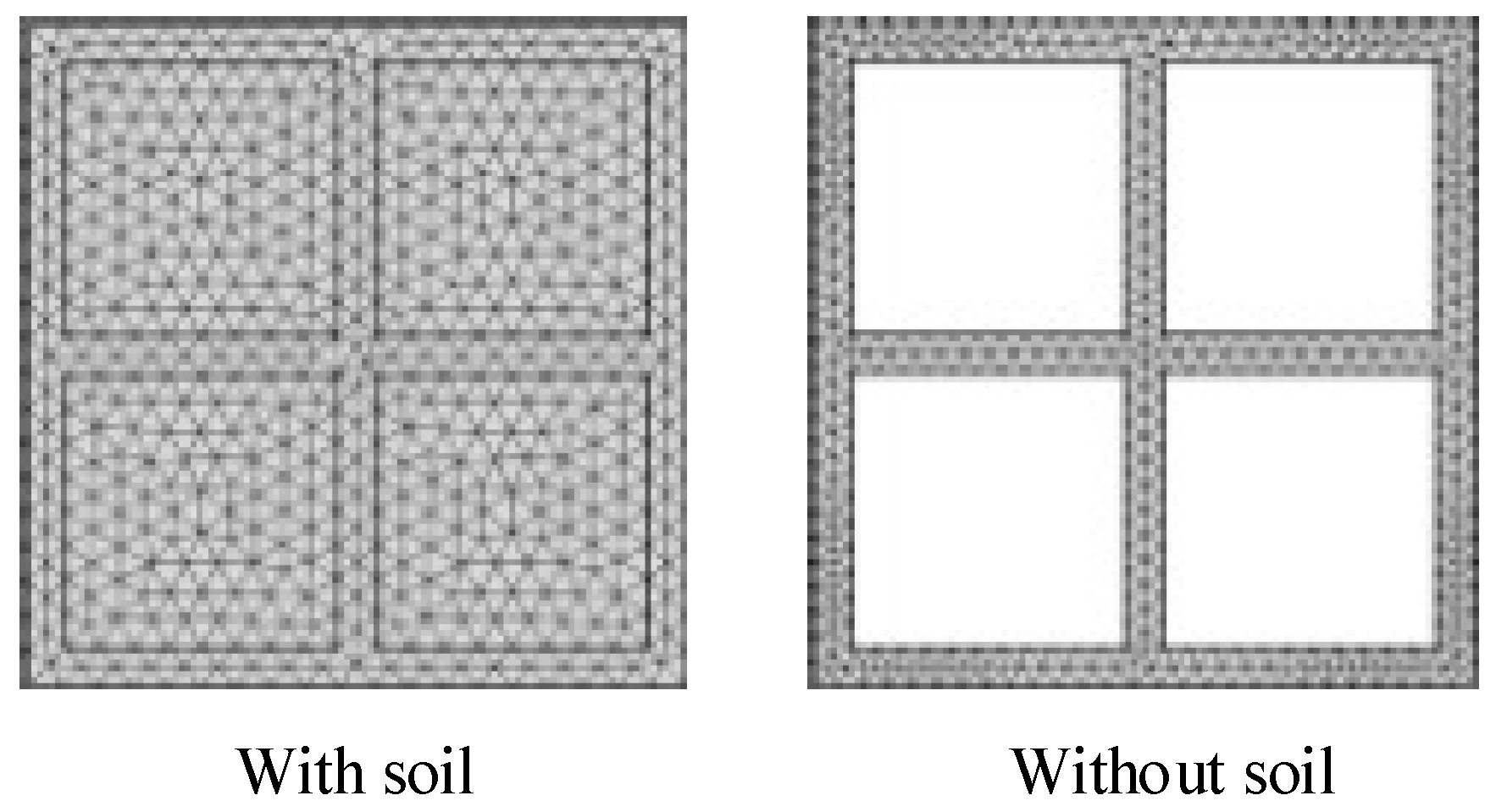
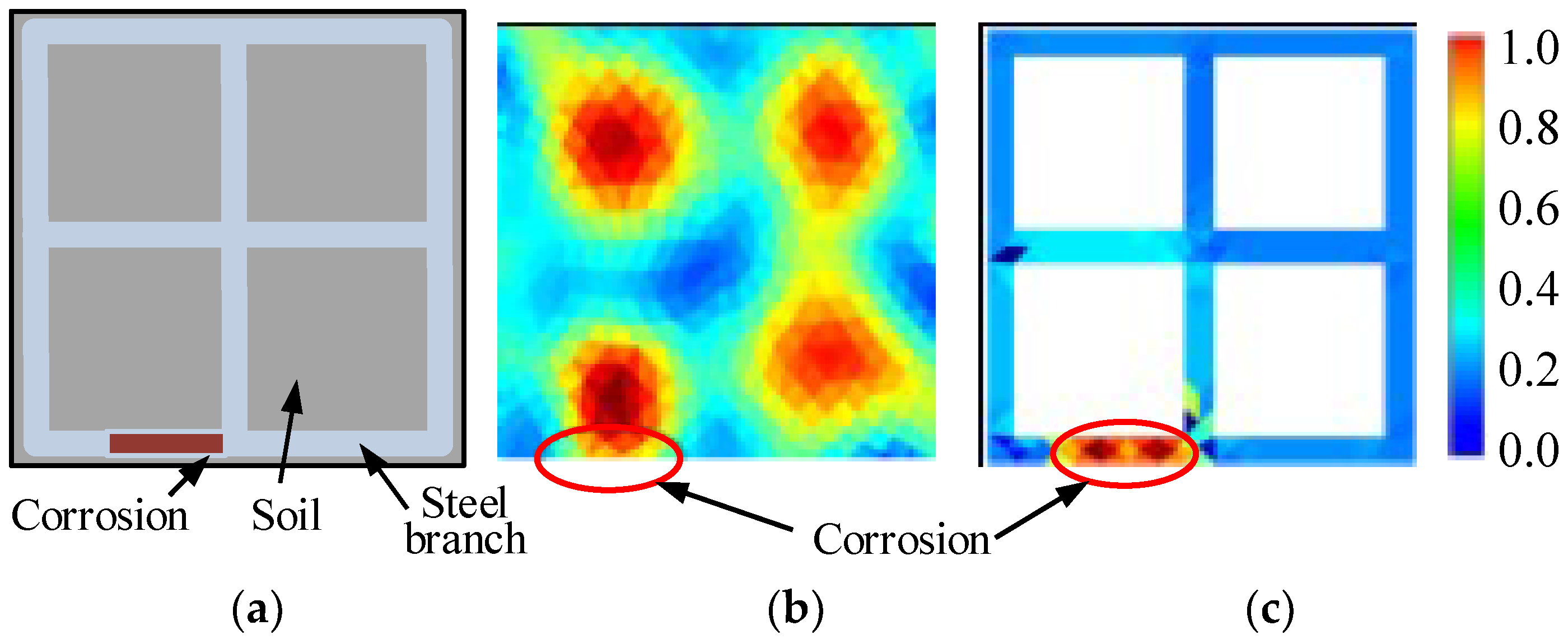

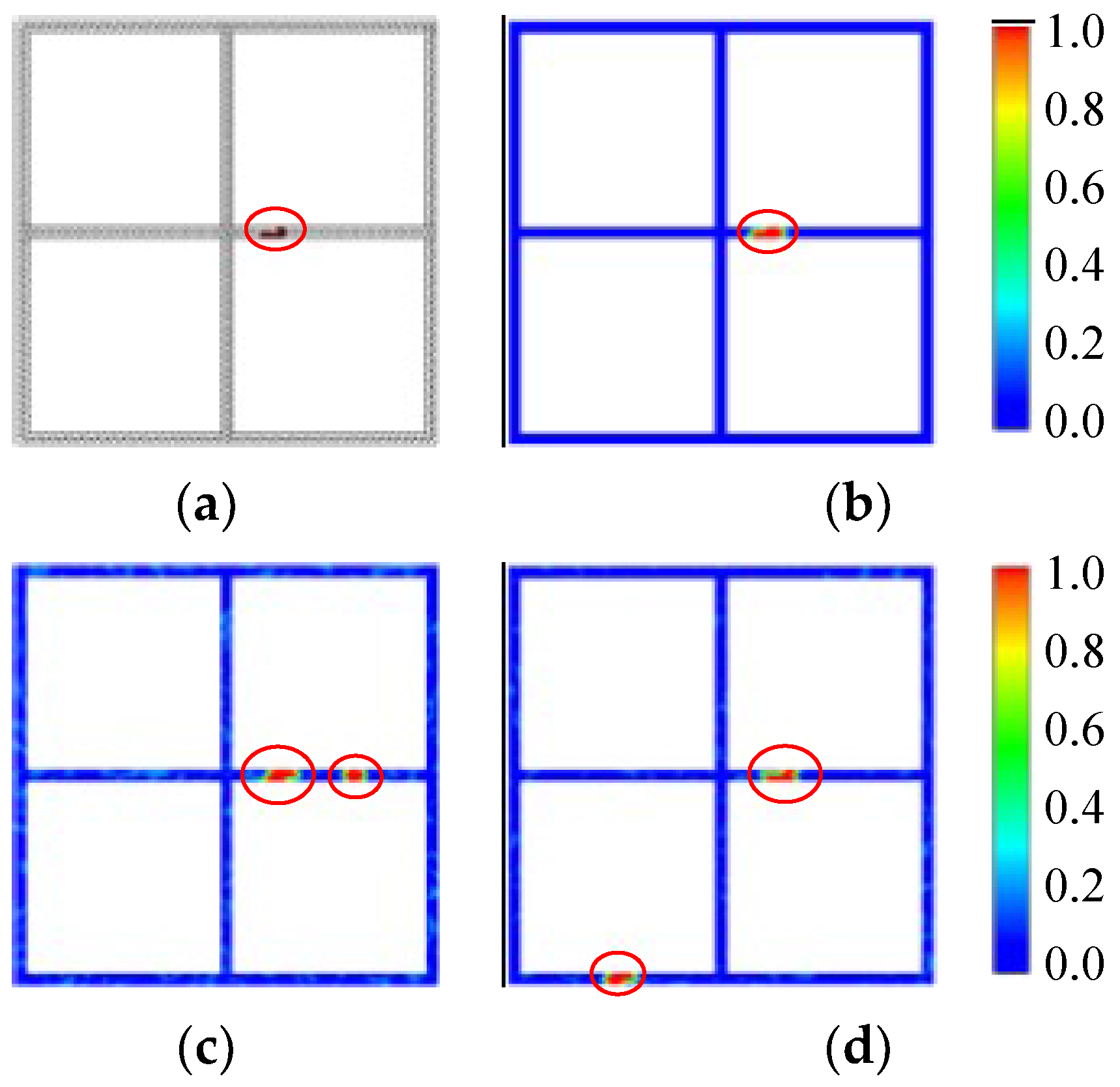
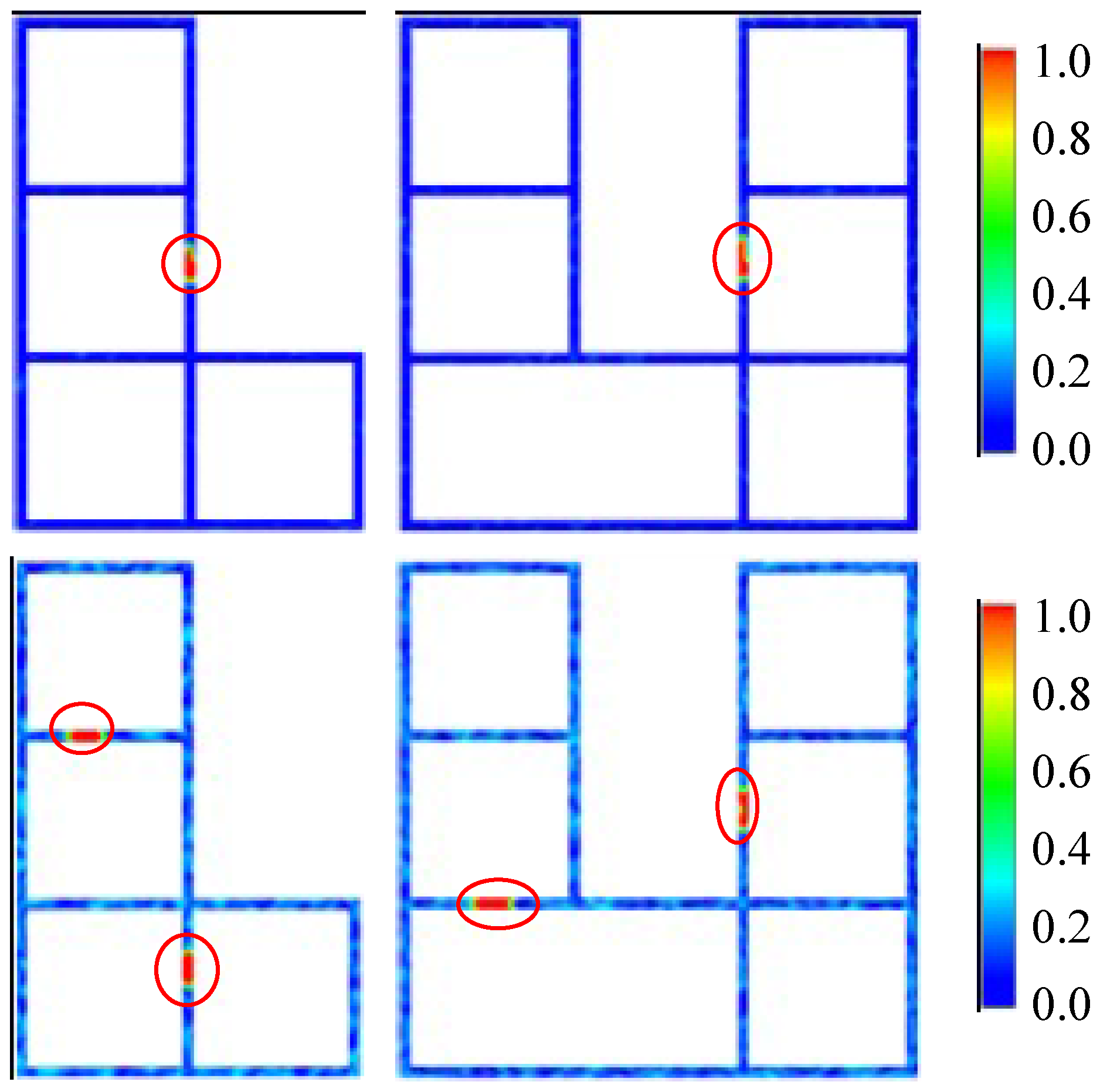
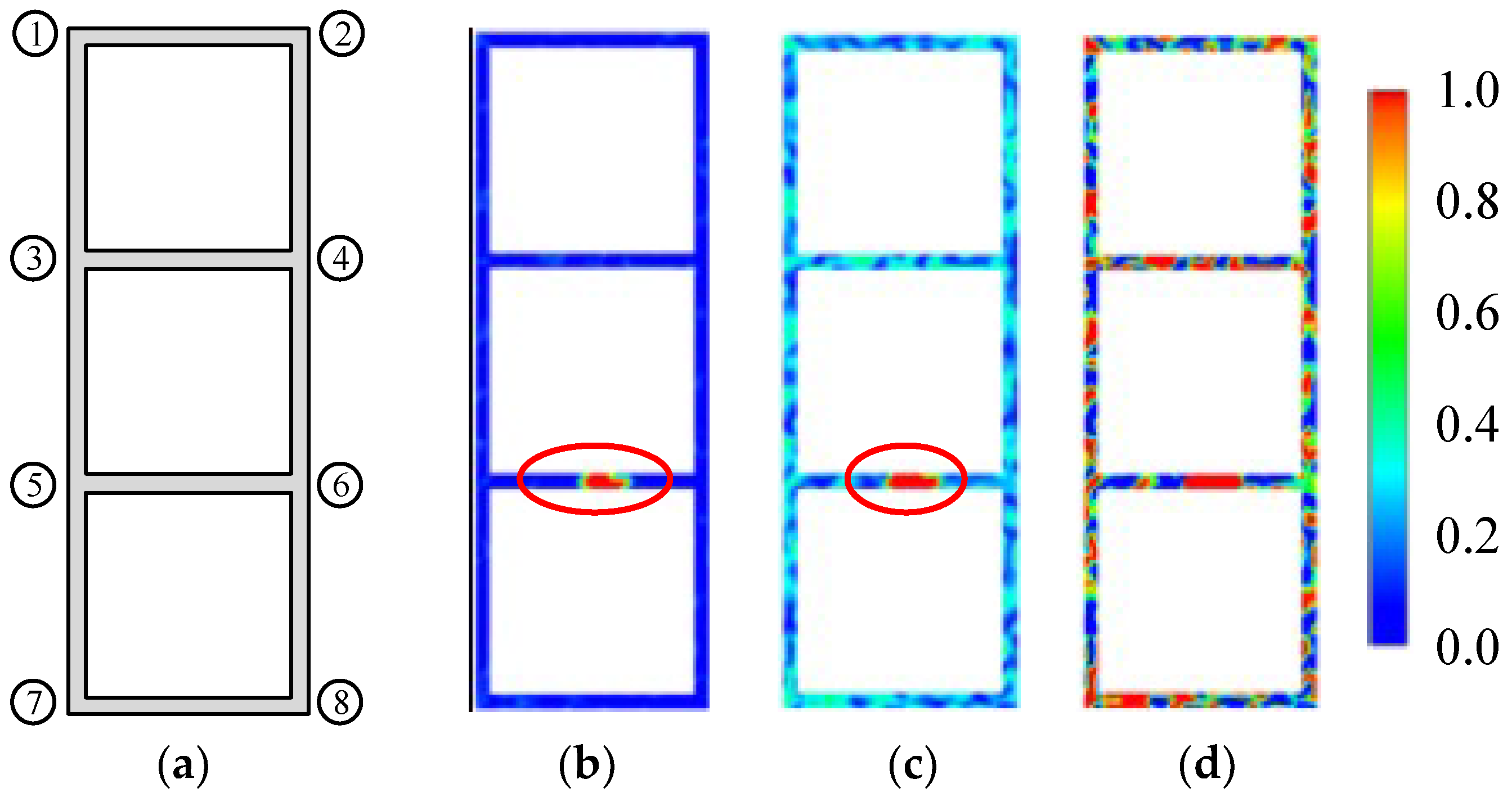

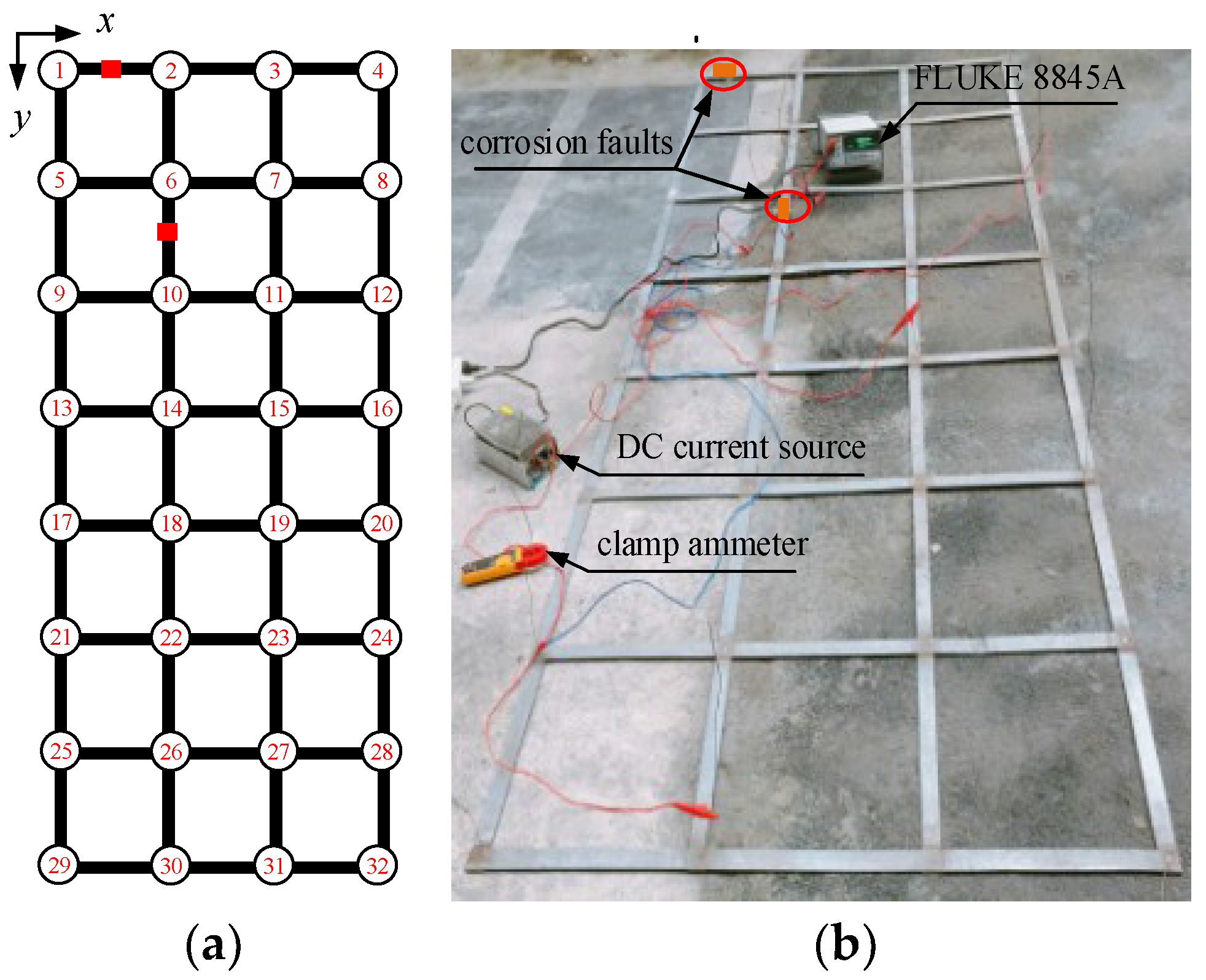
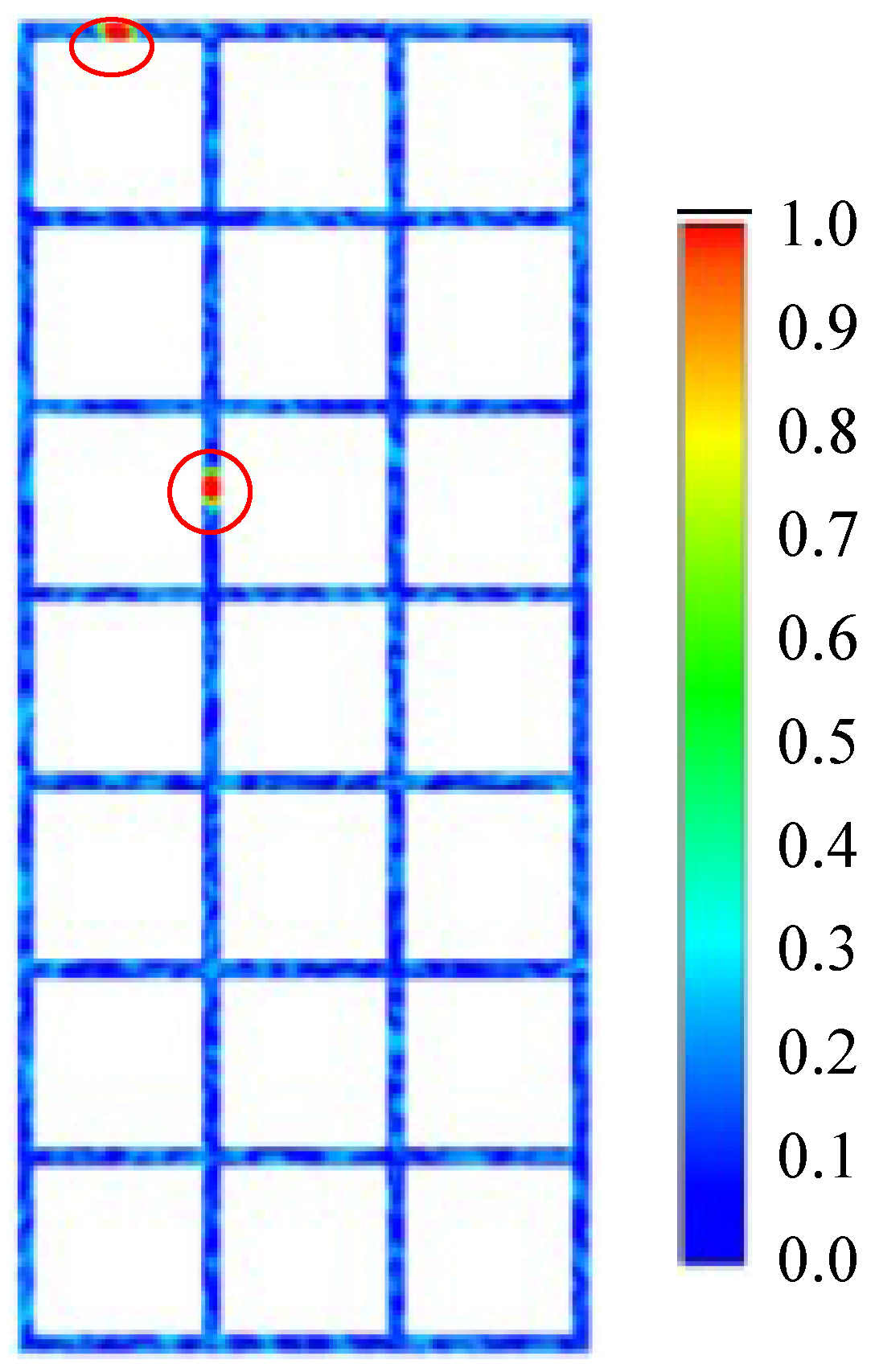
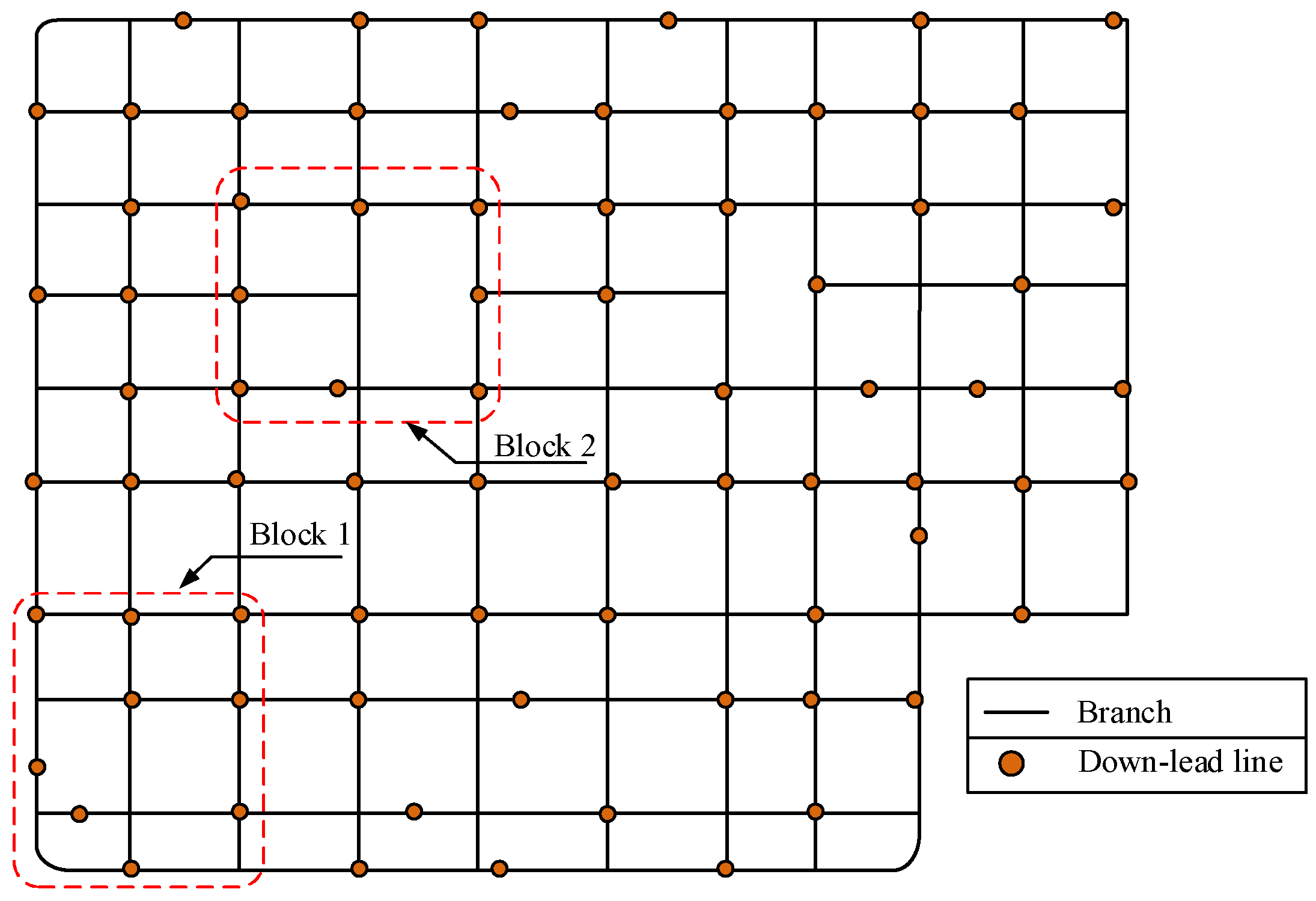

| Property | Medical EIT | Grounding Grid EIT |
|---|---|---|
| region | biological tissue | the field of grounding grid |
| target | lesion tissue | corroded branch |
| measurement | measuring electrodes | grounding down-lead lines |
| size | small size | big size |
| resistivity contrast | low | high |
| Node | Potential/mV | Node | Potential/mV | Node | Potential/mV |
|---|---|---|---|---|---|
| 1 | −2.8311 | 11 | −3.0250 | 23 | −2.5960 |
| 2 | −2.8584 | 13 | −2.2692 | 24 | −0.2801 |
| 4 | −2.9867 | 15 | −3.2817 | 26 | 0.7914 |
| 5 | −2.7512 | 16 | −3.3517 | 28 | 2.3319 |
| 6 | −2.8305 | 17 | −1.7492 | 29 | 0 |
| 7 | −2.9624 | 18 | −1.9289 | 31 | 1.3855 |
| 10 | −2.7917 | 21 | 0.8712 | 32 | 1.8743 |
© 2018 by the authors. Licensee MDPI, Basel, Switzerland. This article is an open access article distributed under the terms and conditions of the Creative Commons Attribution (CC BY) license (http://creativecommons.org/licenses/by/4.0/).
Share and Cite
Li, X.; Yang, F.; Ming, J.; Jadoon, A.; Han, S. Imaging the Corrosion in Grounding Grid Branch with Inner-Source Electrical Impedance Tomography. Energies 2018, 11, 1739. https://doi.org/10.3390/en11071739
Li X, Yang F, Ming J, Jadoon A, Han S. Imaging the Corrosion in Grounding Grid Branch with Inner-Source Electrical Impedance Tomography. Energies. 2018; 11(7):1739. https://doi.org/10.3390/en11071739
Chicago/Turabian StyleLi, Xing, Fan Yang, Julan Ming, Ammad Jadoon, and Sheng Han. 2018. "Imaging the Corrosion in Grounding Grid Branch with Inner-Source Electrical Impedance Tomography" Energies 11, no. 7: 1739. https://doi.org/10.3390/en11071739




